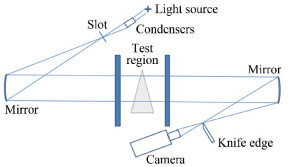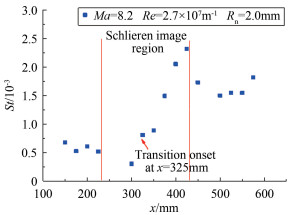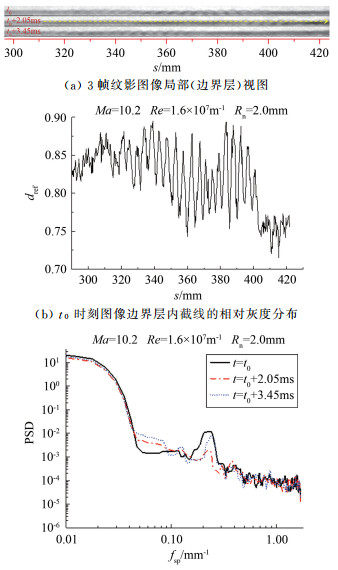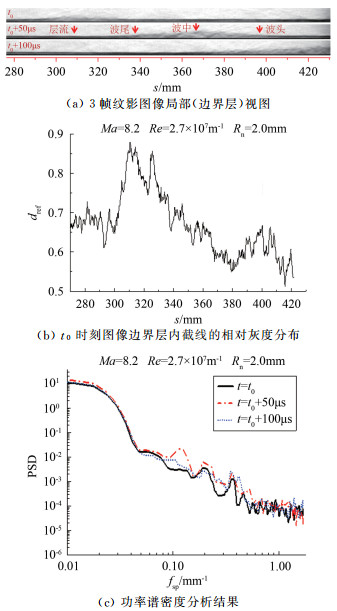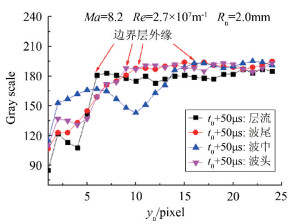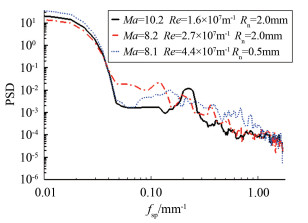Schlieren visualization of hypersonic boundary layer transition on a circular cone
-
摘要: 为发展高超声速边界层转捩的试验研究手段,在中国空气动力研究与发展中心(CARDC)超高速空气动力研究所的FD-14激波风洞上开展了基于纹影显示技术的边界层转捩特性研究。试验模型为半锥角为7°的钝锥,头部钝度Rn有2.0和0.5mm两种。试验的名义马赫数为8和10,单位雷诺数变化范围为1.6×107~4.4×107m-1,高速相机的拍摄帧频20kHz。纹影显示捕捉到了第二模态不稳定波和湍流斑的空间结构。对纹影图像的灰度分布进行了功率谱密度(PSD)分析,结果表明第二模态波长约为边界层厚度的2倍。对纹影图像序列的分析表明,湍流斑波前传播速度大于波尾,并且略大于边界层外缘速度。Abstract: To develop the experimental technique for investigating the hypersonic boundary layer transition, schlieren visualization is used to study the characteristics of the boundary layer transition in the FD-14 shock tunnel at the Hypervelocity Aerodynamics Institute of China Aerodynamics Research and Development Center(CARDC). The test model is a 7° half-angle blunt cone with two different nosetip radiuses, 2.0 and 0.5mm, respectively. The nominal Mach numbers are 8 and 10 and the unit Renolds number varies from 1.6×107 to 4.4×107 m-1. The high-speed camera's frame frequency is 20kHz. Structures of the second mode instability waves and turbulent spots are obtained by schlieren visualization and the power spectral density is analyzed based on the gray scale distribution of schlieren images. Results indicate that the wavelength of the second mode wave is nearly twice as large as the boundary layer thickness. Analysis results of the schlieren image sequence show that the propagation speed of the turbulent spot front is higher than that of the turbulent spot tail, and is slightly higher than the velocity of the boundary layer outer edge.
-
Keywords:
- boundary layer transition /
- schlieren visualization /
- second mode /
- turbulent spot
-
0 引言
边界层转捩是高超声速飞行器设计和高超声速流动机理研究中的关键问题,地面风洞试验则是研究高超声速边界层转捩问题的重要一环。传统的转捩相关的风洞试验主要采用接触式、点测量式的测量方法,重点关注转捩位置。随着电子技术和光学显示手段的发展,传统纹影显示等非接触测量方式的试验能力有了大幅提升,空间和时间分辨率明显提高, 能够获取更为全面的转捩流动信息。
早期的研究者诸如Demetriades[1]、Smith[2]通过高超声速圆锥边界层转捩试验获得了边界层的纹影图像,并且发现了边界层的绳状波包结构(即第二模态波)。鉴于当时的试验条件,每车次只能获得单张纹影图像,无法获得转捩边界层在时间域上的变化特点。近年来,高速纹影的发展弥补了上述不足。Casper[3]开展了Ma5和Ma8条件下的圆锥边界层转捩高速纹影试验,分析了第二模态波不稳定性增长和破碎为湍流斑的过程。Bonucci[4]开展了Ma9和Ma11圆锥边界层转捩试验研究,用快速傅里叶变换(FFT)方法分析了纹影图像中扰动波的波长分布特点。Laurence[5]开展了高焓条件下的圆锥边界层转捩试验研究,采用激光光源的四脉冲模式实现了超过相机帧频的时间分辨率,分析了边界层的扰动波包在时域上的运动特性。Kennedy[6]在Ma10和Ma14尖锥边界层转捩试验中对基于纹影图像的空间数据进行了时间域的重构,由此得以分析边界层固定位置的法向功率谱密度(PSD)特性。VanDercreek[7]和Hofferth[8]采用聚焦纹影技术研究了高超声速转捩边界层的扰动发展特性。国内在高超声速边界层转捩试验研究方面采用的光学测量手段主要有粒子图像测速法(PIV)[9-10]、温敏漆技术(TSP)[9-11]和纳米粒子平面激光散射技术(NPLS)[12],也有利用气动光学诊断技术开展的研究[13],而采用纹影手段的研究较少。此外,国外相关的试验研究多数在静音风洞中开展,而在脉冲风洞中的研究较少。
本文采用纹影显示技术,结合铂薄膜热流传感器对转捩位置进行测量,通过在FD-14激波风洞上开展试验来研究Ma8和Ma10来流条件下钝锥边界层转捩过程中扰动发展的特性。
1 试验条件
1.1 试验风洞、模型及流场条件
FD-14激波风洞是一座反射运行的激波风洞,驱动气体为氢气与氮气的混合气体,被驱动气体为氮气。喷管出口直径0.6m,可模拟的马赫数范围为6~12,雷诺数范围为2.1×105~6.5×107m-1,有效试验时间为2~13ms。本文的3种流场条件如表 1所示。根据CARDC超高速空气动力研究所激波风洞转捩试验的经验,在其他条件给定的情况下,马赫数越小或雷诺数越大,则转捩更易发生。因此, 试验流场选择的依据在于尽可能包含更多的转捩阶段,以便较为全面地研究转捩从酝酿到尾声过程中出现的流动现象,如第二模态波和湍流斑。
表 1 流场条件Table 1 Freestream conditions流场 Ma∞ Re∞/m-1 U∞/(m·s-1) 1 8.2 2.7×107 1329 2 8.1 4.4×107 1228 3 10.2 1.6×107 1376 试验模型为半锥角7°的圆锥,轴向长度593.1mm,模型头部可更换,头部钝度Rn有0.5和2.0mm两种。试验中所有车次的模型迎角均为0°。试验采用铂薄膜热流传感器测量锥模型1条子午线上的热流分布,从热流变化的角度来监测边界层的流态。
1.2 纹影系统
采用Z型反射式纹影光路布置(见图 1)。光源为Osram 400W连续光源。相比FD-14风洞配备的传统纹影系统,本文使用的球面镜直径缩小了1倍,达到0.2m,使得单位面积内的像素点数增加3倍,提升了纹影图像的空间分辨率。该纹影光路的焦距为2m。刀口水平布置,即测量竖直方向的密度梯度引起的光强变化。相机的空间分辨率为1024pixel×1024pixel,帧频20kHz,光线经过边界层,会因为密度不均匀而产生偏折角,1mm空间包含的像素点数为3.4个。
纹影显示测量边界层内扰动结构的原理在于:光线经过边界层,会因为密度不均匀而产生偏折角,偏折角与光线在成像平面上的相对光强成正比;如果忽略光路积分效应,偏折角与边界层密度梯度(垂直刀口方向)成正比;而对于锥体这样的旋成体绕流来说,光路积分效应较弱,纹影显示能较好反映流场结构变化。因此,纹影图像的灰度分布特征和边界层内某一方向密度梯度分布近似,通过对灰度分布进行功率谱密度(PSD)分析,可以得到边界层内占主导地位扰动的特征长度。
以锥模型的理论尖点为原点,锥的对称轴为x轴,壁面外法向为yn轴,将从原点出发平行于锥体子午线方向定义为s轴,s坐标的意义即为锥体上某点到原点的距离,s轴与x轴的夹角即为半锥角。试验布置的纹影视窗的x方向范围为236~436mm。
2 结果与分析
2.1 转捩开始位置
早期的转捩试验主要着眼于测量转捩开始位置,随着转捩研究的深入,重点扩展到测量边界层在转捩过程中各类扰动所引起的流动参数的变化[5],比如压力、温度/热流、密度/密度梯度及其时空脉动特性。
以St数作为热流无量纲化的参数,其计算公式如下:

(1) 其中ρ∞为自由来流密度,h0为自由来流总焓,hw为壁面焓值,qw为壁面热流。转捩开始位置的判据为该位置的热流相对上游临近位置明显上升。图 2、3给出了在热流传感器测量范围和纹影视窗范围内转捩启动试验状态下的子午线St数分布。在流场1、Rn=2.0mm的条件下,转捩开始位置为x=325mm;在流场3、Rn=2.0mm的条件下,转捩开始位置为x=400mm。
2.2 第二模态波
图 4(a)给出了流场3、Rn=2.0mm的条件下3帧纹影图像的局部视图,其中t0代表第一张图像对应的时刻,不同流场条件的t0值是不同的。每张图像都有绳状波的存在。后处理过程中,在边界层内提取一条平行于壁面(0.6mm < yn < 1.5mm)的流向截线(图 4(a)中黄色箭头线所示)的灰度分布(Bicubic插值法),该截线在流向区上基本涵盖整个纹影视窗范围(直线两端避开边缘虚化严重的区域)。以无流场(真空)的纹影图像作为参考值进行平均化处理(相对灰度记为dref),以减弱边缘虚化和背景扰动的影响,然后对其作PSD分析,得到的PSD曲线横坐标为空间频率(波数)fsp,纵坐标为PSD值。图 4(b)给出了截线的相对灰度分布,其呈现明显的周期波动特征。图 4(c)对比了3个时刻纹影图像相应的PSD曲线,结果显示,3个时刻对应的PSD均在fsp=0.23mm-1附近存在峰值,即对应扰动波的波长λ=4.3mm。
本文用密度梯度边界层来定义边界层厚度,从壁面开始沿外法向到灰度不再明显上升处,认为该处即为边界层外缘。通过边缘识别方法[3]获得图 4(a)对应的边界层厚度为δ=2.1mm,则有λ/δ=2.05,与Stetson[14]测量第二模态波的结果符合较好。
判断绳状波为第二模态波的依据为,通过估算此类扰动波的传播速度,并结合图像分析得到的波长结果,就可以根据波传播理论的速度-波长关系直接得出其频率。一般来说,扰动波传播速度为边界层外缘速度的0.91倍左右[6],而对半锥角7°的圆锥绕流来说,根据斜激波关系式可以估算边界层外缘速度约为97%的自由来流速度,据此估算得到流场3的边界层扰动波的频率约为282kHz。此外,第二模态波的主频率fsecond(对应扰动幅值最大)可用如下经验公式[15]估算:

(2) 其中,Ue为边界层外缘速度。对流场3来说,第二模态波的主频率可估计在286kHz左右,282kHz与其偏差仅为1.4%。综上所述,本文认定通过纹影图像发现的绳状波即为第二模态波。
2.3 湍流斑
图 5(a)给出了流场1、Rn=2.0mm条件下连续3帧显示局部边界层的纹影图像。结果显示边界层内存在较大范围的孤立扰动波结构。t0+50μs时刻4个不同流向位置的法向灰度分布(图 6)以及t0时刻流向截线的灰度分布(图 5(b))可以看出边界层厚度的显著差异。在扰动波的波中位置,边界层厚度接近层流位置的3倍,波头和波尾的边界层厚度也超过了层流的1.5倍。这种边界层厚度特征以及其孤立于层流边界层中的特点,乃是湍流斑的特征[16]。
初始时刻t0对应的纹影图像显示湍流斑在上游位置,其流向尺度约为37mm; t0+50μs时刻对应的纹影图像显示湍流斑往下游发展,其流向尺度增长到约70mm; t0+100μs时刻,湍流斑发展到更下游的位置,波头已经超出了纹影视窗范围,而视窗内所显示的结构的流向尺度约71mm,说明其完整尺度明显大于71mm。根据图 5(a)计算得到的湍流斑传播速度如表 2所示,其中Uf为波头速度,Ut为波尾速度。
表 2 湍流斑传播速度Table 2 Propagation speed of turbulent spot区间 t0~t0+50μs t0+50μs~t0+100μ Uf/(m·s-1) 1400 — Ut/(m·s-1) 740 760 Ut/U∞ 0.56 0.57 表 2表明:首先,湍流斑的波头传播速度大于自由来流速度U∞,也即肯定大于边界层外缘速度,这说明湍流斑的传播速度叠加了边界层外缘速度和波头下游扰动破碎为湍流结构的“速度”,湍流斑波头可能对下游边界层存在一定的诱导作用;其次,湍流斑的波尾速度在100μs的区间内变化较小,这说明波尾上游的边界层相对稳定。
PSD曲线(图 5(c))呈现多峰值的特征,在fsp=0.12、0.20、0.36mm-1附近的3个峰值较为明显。t0+100μs时刻由于湍流斑有一部分超出了视窗范围,其PSD曲线在fsp=0.12 mm-1处并无明显峰值特征。需要指出的是,该试验状态下,湍流斑的上游并未观察到明显的第二模态波的绳状结构:这可能和Ma8条件下边界层较薄以及光路积分效应有关,即绳状结构并非不存在而是没有观察到;也可能和转捩路径有关,由于激波风洞噪声水平相比静音风洞和低噪声风洞要大很多,边界层可能并不存在线性增长的第二模态波发展阶段(或存在极短,不易观测),而是直接破碎为湍流斑从而启动转捩,这需进一步研究确认。
2.4 完全湍流及不同边界层特征对比
图 7给出了流场2、Rn=0.5mm条件下连续3帧纹影图像,其上下游边界与纹影视窗边界层一致,可以看到边界层具有比较清晰的湍流结构。对应的PSD曲线(图 7(c))表明,在湍流条件下,边界层扰动能量呈现相对宽谱的分布特点,即fsp从0.05到0.40mm-1的范围内, 各个频段的PSD幅值分布较为平滑。
图 8比较了3种不同边界层状态的PSD曲线,分别对应第二模态波、湍流斑和完全湍流的情形,这种对比更为清楚地显示了不同边界层状态下,流线上空间谱特征的区别。
结果显示,在第二模态波结构明显可见(流场3,Rn=2.0mm)的边界层空间,即转捩开始位置(结合图 3和4(a))附近的区域,边界层的扰动能量在第二模态波波长的频段有所集中,且明显大于高频部分和0.05mm-1以上(即波长20mm以下)的低频部分。当湍流斑出现时(流场1,Rn=0.5mm),湍流斑在转捩带前后段都会出现(结合图 2和6(a)),空间PSD分布呈现出多个峰值的特点,这意味着在湍流斑形成的上一个阶段(即非线性增长阶段)得到显著发展的第二模态波破碎了,其能量主要分布到具备几个特征尺度的湍流结构上。当边界层变为完全湍流时(流场2,Rn=0.5mm),空间PSD分布的峰值特征并不明显,这说明当完全湍流时, 边界层扰动的能量从集中在几个特征波长发展到更为平均地分布在更广的空间频段上。上述第二模态波、湍流斑和完全湍流边界层的边界层流向PSD特征和Bonucci[4]的研究结果一致。
需要说明的是,一般来说Ma数在6~8以上,主导零迎角的圆锥边界层转捩的不稳定波为第二模态波,第一模态不稳定波在高Ma数下的幅值较弱,本文也并未在试验中发现第一模态波的迹象。此外,圆锥边界层转捩的过程主要有几个重要阶段:首先,第二模态波幅值经过较长的线性增长,再经过较短的非线性增长后趋于饱和并破碎为孤立的湍流斑,最后,湍流斑发展融合为完全湍流。本文虽然未能在同一试验状态同一车次试验下同时捕捉到上述几个阶段的现象,但通过不同试验状态的观测,仍实现了相对完整的转捩过程边界层纹影结构的呈现。
3 结论
通过纹影显示方法对钝锥边界层在激波风洞Ma8和Ma10来流条件下的边界层转捩过程进行了试验研究,总结出如下结论:
(1) Ma8条件下湍流斑的流向PSD曲线存在多个峰值,说明边界层包含多个能量较强、特征尺度不同的流动结构。
(2) 边界层处于不同阶段,对应着不同空间扰动的能谱分布特征:在第二模态波主导阶段,扰动能量呈单峰分布特征;湍流斑出现时,扰动能量在多个波长上集中;完全湍流时,扰动能量呈比较明显的宽谱分布特征。
(3) 湍流斑波头传播速度略大于边界层外缘速度,原因可能在于湍流斑对下游边界层的失稳存在诱导作用。Ma8条件下湍流斑的形成机理仍需进一步研究。
更深入的工作将围绕提高纹影系统的时间分辨率和局部空间分辨率进行,从而更全面地获取边界层扰动发展的时域特性和空间分布特征。
-
表 1 流场条件
Table 1 Freestream conditions
流场 Ma∞ Re∞/m-1 U∞/(m·s-1) 1 8.2 2.7×107 1329 2 8.1 4.4×107 1228 3 10.2 1.6×107 1376 表 2 湍流斑传播速度
Table 2 Propagation speed of turbulent spot
区间 t0~t0+50μs t0+50μs~t0+100μ Uf/(m·s-1) 1400 — Ut/(m·s-1) 740 760 Ut/U∞ 0.56 0.57 -
[1] Demetriades A. Hypersonic viscous flow over a slender cone. part Ⅲ: laminar instability and transition[R]. AIAA-74-535, l974.
[2] Smith L G. Pulsed-laser schlieren visualization of hypersonic boundary-layer instability waves[R]. AIAA-94-2639, 1994.
[3] Casper K M, Beresh S J, Henfling J F, et al. High-speed schlieren imaging of disturbances in a transitional hypersonic boundary layer[R]. AIAA-2013-0376, 2013.
[4] Bonucci G, Grossir G, Regert T, et al. Optical characterization of boundary layer transition in hypersonic flows[C]//Proc of the 17th International Symposium on Applications of Laser Techniques to Fluid Mechanics. 2014.
[5] Laurence S, Wagner A, Hannemann K. Experimental study of second-mode instability growth and breakdown in a hypersonic boundary layer using high-speed schlieren visualization[J]. Journal of Fluid Mechanics, 2016, 797:471-503. DOI: 10.1017/jfm.2016.280
[6] Kennedy R E, Laurence S J, Smith M S, et al. Hypersonic boundary-layer transition features from high-speed schlieren images[R]. AIAA-2017-1683, 2017.
[7] VanDercreek C P, Smith M S, Yu K H. Focused schlieren and deflectometry at AEDC hypervelocity wind tunnel No.9[R]. AIAA-2010-4209, 2010.
[8] Hofferth J W, Humble R A, Floryan D C, et al. High-bandwidth optical measurements of the second-mode instability in a Mach 6 quiet tunnel[R]. AIAA-2013-0378, 2013.
[9] Zhu Y D, Zhang C, Chen X, et al. Transition in hypersonic boundary layers:role of dilatational waves[J]. AIAA Journal, 2016, 54(10):3039-3049. DOI: 10.2514/1.J054702
[10] Zhu Y D, Chen X, Wu J Z, et al. Aerodynamic heating in hypersonic boundary layers: role of second-mode waves[R]. AIAA-2017-2127, 2017.
[11] 张扣立, 常雨, 孔荣宗, 等.温敏漆技术及其在边界层转捩测量中的应用[J].宇航学报, 2013, 34(6):860-865. DOI: 10.3873/j.issn.1000-1328.2013.06.017 Zhang K L, Chang Y, Kong R Z, et al. Temperature sensitive paint technique and its application in measurement of boundary layer transition[J]. Journal of Astronautics, 2013, 34(6):860-865. DOI: 10.3873/j.issn.1000-1328.2013.06.017
[12] 李睿劬, 宫建, 毕志献, 等.高超声速平板边界层的气动光学诊断技术[J].空气动力学学报, 2017, 35(1):136-140. DOI: 10.7638/kqdlxxb-2015.0103 Li R Q, Gong J, Bi Z X, et al. Aero-optical diagnostic technique for hypersonic boundary layer transition on a flate plate[J]. Acta Aerodynamica Sinica, 2017, 35(1):136-140. DOI: 10.7638/kqdlxxb-2015.0103
[13] 付佳, 易仕和, 王小虎, 等.高超声速平板边界层流动显示的试验研究[J].物理学报, 2015, 64(1):014704. http://d.old.wanfangdata.com.cn/Periodical/wlxb201501021 Fu J, Yi S H, Wang X H, et al. Experimental study on flow visualization of hypersonic flat plate boundary layer[J]. Acta Physica Sinica, 2015, 64(1):014704. http://d.old.wanfangdata.com.cn/Periodical/wlxb201501021
[14] Stetson K F, Kimmel R L. On the breakdown of a hypersonic laminar boundary layer[R]. AIAA-93-0896, 1993.
[15] Heitmann D, Kähler C, Radespiel R, et al. Non-intrusive generation of instability waves in a planar hypersonic boundary layer[J]. Experiments in Fluids, 2011, 50(2):457-464. DOI: 10.1007/s00348-010-0949-2
[16] Gad-el-Hak M, Riley J J. Visualization study of turbulent spots[R]. ADA118441, 1982.
-
期刊类型引用(3)
1. 刘美宽,韩桂来,姜宗林. 高超声速平板边界层数值模拟及试验研究. 气动研究与试验. 2023(05): 51-61 .  百度学术
百度学术
2. 徐席旺,易仕和,张锋,郑文鹏,米琦. 高超声速圆锥边界层转捩实验研究. 气体物理. 2022(03): 45-59 .  百度学术
百度学术
3. 李强,江涛,陈苏宇,常雨,赵磊,张扣立. 激波风洞边界层转捩测量技术及应用. 航空学报. 2019(08): 66-77 .  百度学术
百度学术
其他类型引用(2)






 下载:
下载:
